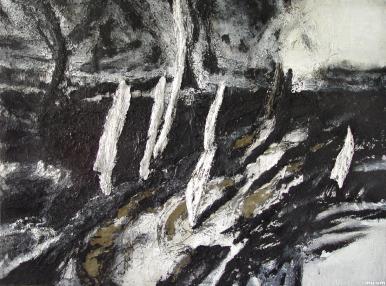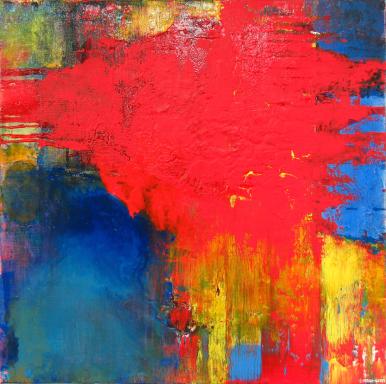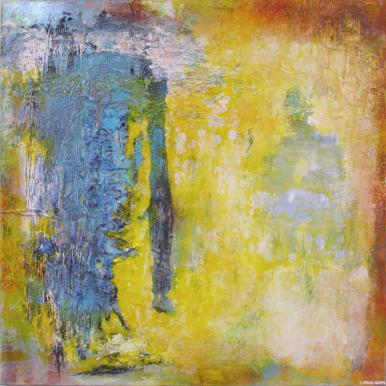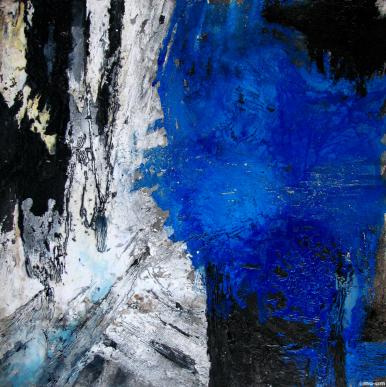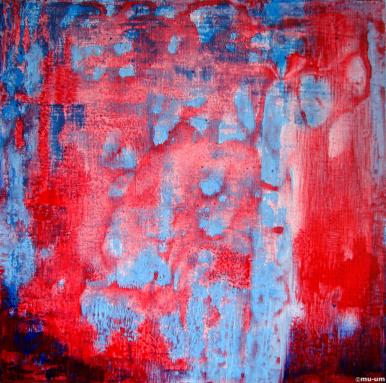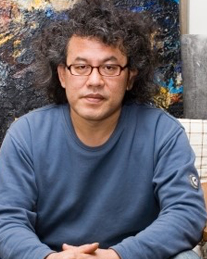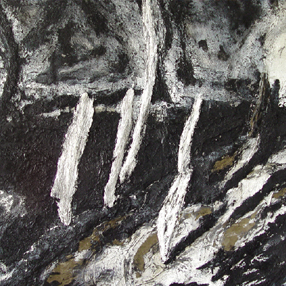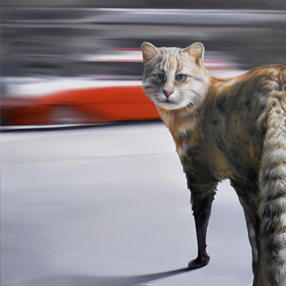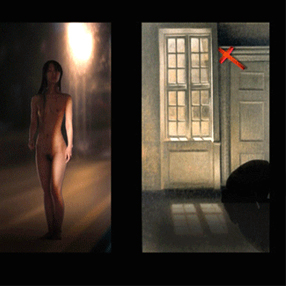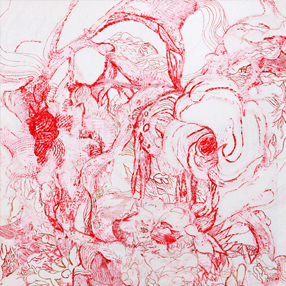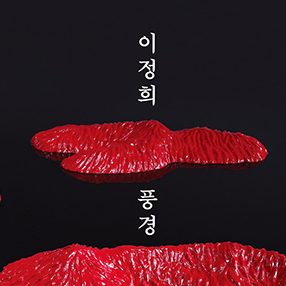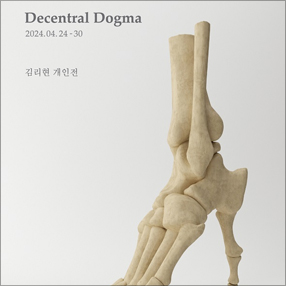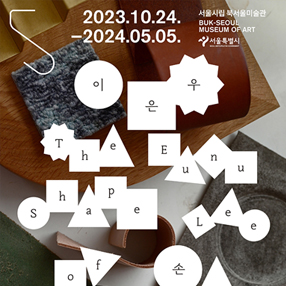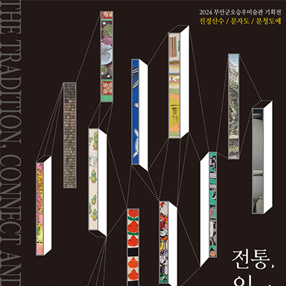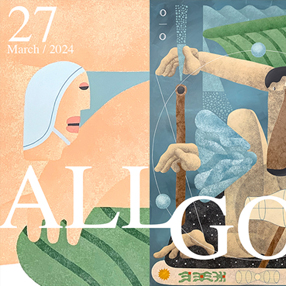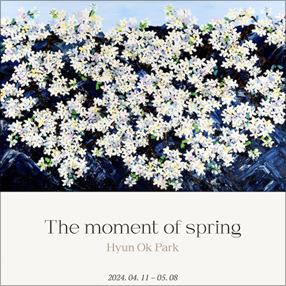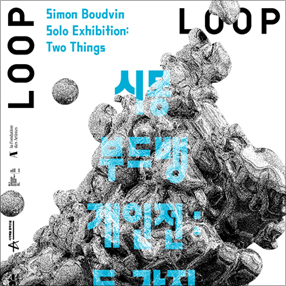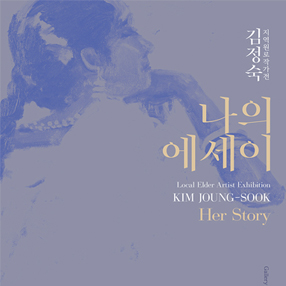본문
-
김유섭
검은 그림 3(Schwarze Malerei 3) mixed media on canvas, 150x200cm, 2005
-
김유섭
Energy Field II #37-2009 mixed media on canvas, 80x80cm, 2009
-
김유섭
Energy Field II #12-2011 Acrylic on canvas, 100x100cm, 2011
-
김유섭
Blue Acrylic on canvas, 120x120cm, 2009
-
김유섭
r+b+w Acrylic on canvas, 80x80cm, 2012
-
Press Release
자연의 심부에서
색의 싹을 틔운 회화들
김종길 | 미술평론가
“내가 원하는 것은 순수한 감정의 절대성이다”
- 말레비치(Malevich, Kazimir Severinovich)
김유섭은 긴 전화인터뷰의 말미에 ‘절대주의’를 꺼냈다. 20세기 초반, 추상 회화의 구체성을 밝힌 말레비치의 회화 개념인 그것. 19세기 후반 사진의 등장이후 회화의 재현기능이 시나브로 그 미학적 힘을 상실하기 시작했다는 사실은 이미 역사적 정설이다. 낭만주의와 사실주의를 거쳐 도달한 회화적 저항은-재현 혹은 사실성에 대한 저항일수도 있고 사진에 대한 저항일수도 있는-추상이라는 오아시스에 도달하게 된다. 근대 ‘추상’ 회화의 발견은 인류가 동굴에 벽화를 그린 이후 가장 파격에 가까운 판타지였을 것이다. 이제 화가는 대상의 표피나 그 표피를 둘러싼 해부학적 이해 따위의 ‘물성’이 아니라 그것의 본성 혹은 본질에 다가설 수 있게 되었기 때문이다. 말레비치에게 있어 추상의 ‘구체성’은 객관적 현실에 존재하는 대상의 재현이 아니라 사물의 본질이었으며, 그 본질이 형성하고 있는 일종의 ‘원형상’(근원적 형상)이었던 셈이다. 우리는 바로 그 원형상을 통해 화가의 내적 감성에 도달하게 될 것이다.
말레비치가 원과 사각형을 통해 절대주의 회화를 표현했다는 것은 이제 중요하지 않다. 우리가 그를 다시 호명하거나 새로운 미학 담론을 창출하기 위해선 그의 절대주의에 대한 사유가 무엇이었는지 알 필요가 있다. 초기, “현실세계를 초월하여 대상 없는 정신세계를 표현”하고자 했던 그의 절대성은 1918년 12월 페트로그라드에서 열린 <0,10>이란 전시 이후 “색채가 회화의 부속물이 아니라 독립된 하나의 단위로 존재한다”는 결론에 이른다. 이때 발표한 <흰 바탕의 흰 사각형>은 그의 절대주의 회화의 궁극에 있는 작품이라 할 것이다.
김유섭의 회화를 이해하는 하나의 단서는 말레비치가 절대주의를 선언할 즈음의 미학적 사유에서 발견된다. 즉 그것은 ‘색채의 독립성’이다. 김유섭의 회화는 역설적이게도 말레비치의 절대주의 회화와는 거의 정반대의 위치에 서 있다. 말레비치가 도달한 큐비즘적 형상의 절대성은 어디서도 찾아 볼 수 없을뿐더러 ‘기하학적 구성’의 추상형식도 가지고 있지 않기 때문이다. 우리는 둘의 차이를 그들이 살고 있는/살았던 시대적 배경과 미적 형식, 삶의 리얼리티 모두에서 찾아볼 수 있다. 반면, 색을 드러내기 위한 집요한 사유에서 둘의 공통점을 발견한다. 김유섭에게 있어 색은 독립된 단위로 존재하기 때문이다. 달리 말해 김유섭의 회화는 색 그 자체의 물성에서 비롯된 것이며, 그 낱개의 휘황한 색들이 한데 어울려 발산하는 ‘초월성’에 있다. 김유섭은 이 초월성을 ‘파라다이스’라 명명하고 있는 듯하다. 그렇다면 그의 초월성은 어디에서 연유하는 것이며, 그 초월성이 상징하는 바는 무엇일까.
“회화가 살아남기 위한 실험의 시도로서 기존의 생각과 그에 따른 형태들을 점검하고, 불필요한 형식이나 습관들을 제거하는 작업을 진행하였는데 결국 화면의 색채들조차도 검증을 거치지 않을 수 없었고, 이를 위해 화면상에서 정신적인 지우개를 동원하였는데 이것이 ‘검은 그림’(schwarz Malerei)의 형태로서 나타나게 되었다. 검다는 것은 여기에서, 진부한 물리적 색의 혼합의 결과가 아니라 다시 원점, 즉 태초 시작 전, ‘빛이 있어라’ 직전의 모든 것들이 어둠 속에 머물러 있는 상태일 것 이다. 무엇이 될 것인지, 어떤 형상으로 태어 날 것 인지를 기다리며.”(김유섭)
그는 1995년 베를린 예술대학교의 마이스터를 취득하기 위한 최종구술시험에서 「회화의 끝으로부터 시작(Anfang der Ende der Malerei)」이란 주제의 글을 발표한다. 여기서 그가 핵심적으로 주장하고자 한 내용이 바로 위의 인용글이다. 그는 회화에 대한 절대적 사유를 통해 색이 발생하기 이전의 상황으로 돌아간다. 그가 언급했듯이 그 극지점에는 광막한 어둠만이 존재한다. 검은 빛玄. 나는 이런 그의 사유에서 다시 프랑스의 소설가이자 평론가였던 모리스 블랑쇼(Maurice Blanchot)를 떠올린다. 블랑쇼는, 문학은 황폐의 공간이며 이런 공간 속에서 비로소 글쓰기가 시작된다고 믿었으며, 희망이 사라진 ‘절대적’ 밑바닥에서 진리와 인간의 미래를 긍정할 준비를 해야 한다고 외쳤다. 그래서 그는 근대성이 쌓아올렸던 거대한 이념 더미를 태우는 불꽃을, 그리고 이 더미들이 타고 남은 잿더미를 보여주었으며, 이 잿더미 가운데서 근대성 전체를 회상하면서 그 죽음의 미사를 집전하고 근대성의 조종을 울린 사제라 불리기도 한다. 그가 주목했던 작가들은 횔덜린, 말라르메, 릴케, 카프카, 프루스트와 같이 죽음과 허무로 특징되는, 도달 불가능한 극점에의 접근을 실천한 작가들이었는데, 이들을 통해 그는 인간존재의 원질적 심부를 탐구하고자 하였던 것이다. 김유섭도 근대 회화의 종언을 접한 이후 회화의 ‘황폐한 공간’에 대한 허무적 사유를 마다하지 않는다. 1921년 알렉산드르 로드첸코(Alexander Mikhailovich Rodchenko)가 <5x5=25>라는 전시를 통해 ‘회화의 종언’을 이야기했지만, 그것은 흥미롭게도 말레비치의 절대성 혹은 순수성에 대한 도전이었다. 로드첸코가 언급한 종언으로서의 ‘회화’는 바로 그것, 즉 절대성과 순수성으로의 ‘추상’이기 때문이다. 그는 말레비치의 <흰 바탕 위의 흰 사각형>에 답하여 <검정 위의 검정 Black on Black> 연작을 제작했으며, 말레비치와 달리 예술을 삶으로 전이시키고자 하였다.
김유섭의 사유가 말레비치와 로드첸코의 근대적 회화론보다는 1990년대 이후의 새로운 문명적 매체들의 등장과 급격한 변화, 그리고 그것들의 활약상에 의한 것이지만, 근원적으로는 ‘회화’라는 매체 자체에 대한 것이라 할 수 있다. 회화의 희망이 지속되기 위해선 회화라는 독립된 주체에 대한 사유가 필요했다. 그리고 그가 도달한 곳은 블랑쇼처럼 황폐의 공간이며, 근대 추상회화의 이념들이 타고 남은 잿더미였다. 그것을 ‘빛이 있어라’이전의 어둠이라 표현하든 혹은 색이 발생하기 이전의 어둠 속 대상들이라 주장하든 상관없다. 말레비치의 절대성에 반하여 ‘검정’의 리얼리티를 구사했던 로드첸코의 회화도 그에게는 하나의 색일 따름이다. 그는 한동안 이 검은 빛에 매료되었다. 이 검은 빛은 화면 위의 모든 색을 지웠다. 2007년까지 그의 회화들은 마치 해질녘 어스름처럼 휘몰아 가는 검은 빛들로 난장이었다.
그런데 2008년 이후 그의 화면들은 완전히 새로운 전환에 휩싸인다. 어둠이 밀려나가고 있지 아니한가. 심지어 올해 전시될 작품들에선 검은 빛이 거의 존재하지 않는다. 화면은 응결된 색들이 터지듯 전면적인 확산을 시도하고 있다. 이것은 로드첸코에 대한 도전이라 할 만 하다. 1921년 <5x5=25>의 빨강, 파랑, 노랑 캔버스를 ‘최후의 그림들’이라 명명하며 추상의 죽음을 선포했던 로드첸코의 ‘종언’을 반격이라도 하려는 듯 그의 회화는 빨강과 노랑, 파랑의 생명의지를 생생하게 ‘복권’시키고 있기 때문이다. 뿐만 아니라 이 색들은 씨알들의 환한 생명 에너지를 연상하게 한다. 어둠을 뚫고 싹을 틔우는 생명들의 그 판타지, 작은 미명 속에서 색색의 옷을 드러내는 대자연의 속살들, 그 속살들의 색, 색들의 향연…. 블랑쇼가 절대적 밑바닥에서조차 미래의 긍정을 준비했다면, 그는 검은 빛에서 오랫동안 색의 미명을 발굴했던 것이다. 그는 이렇게 말한다. “황량한 회화 속에서 아직도 무엇이 끈질기게 살아남아 있는지를 살펴보고 그것들을 가꾸고 키워 갈 것이며, 다 죽어버렸다면 그곳 위에 씨를 뿌리고 가꾸어서 새로운 싹이 피어나도록 할 것”이라고.
그의 색들은 황홀한 흔적을 남기고 사라진 빛의 여울처럼 흐르고, 깊은 수면을 응시하는 하늘의 얼굴을 닮았다. 녹음이 우거진 숲과 호수가 경계를 상실한 채 한 몸이 된 듯 색들의 혼합이 힘차다. 뜨거운 심장이 뿜어내는 혈류의 박동을 느낄 수도 있다. 그의 색들은 문명지의 바깥에서 처음 맞닥뜨린 자연의 심부처럼 느껴진다. 이것은 아마도 어둠을 밀어낸 태초의 색일 터이다. 태초의 색은 이성이 아니라 감성일 것이며, 격정에 가까운 에너지일 것이다. 불끈 솟은 첫날의 햇살처럼 모든 색은 한 순간에 터져 나오는 듯하다. 이 색들의 향연에 끼어들 수 미학적 개념이란 한 낱 관념에 불과할지 모른다.
이 글에서 말레비치와 로드첸코를 언급하며 21세기의 김유섭 회화를 빗댄 것은 비약일 수 있다. 모리스 블랑쇼의 문학론도 그렇다. 말레비치와 로드첸코는 미학적 사상을 달리했지만 둘 다 사회주의 혁명이후 스탈린 관료주의의 반대에 부딪쳤다는 것을 상기할 필요가 있으며, 블랑쇼의 사유는 세계대전이라는 세기의 절망에서 비롯되었다는 것도 기억할 필요가 있다. 그러나 김유섭의 회화는 회화 자체에 대한 사유를 지속함으로써 선배세대들이 사유했던 예술의 한 지점과 관통하고 있으며, 나는 그것이 21세기 회화에서도 여전히 유효한 사유일 것이라 믿고 있다. 그러니까 김유섭이 지속하고 있는 회화에 대한 물음은 대단히 진부한 것일 수 있음에도 불구하고, 회화의 근원에 맞닿아 있음으로 해서 새로운 세기의 화두를 명확하게 하고 있는 것이다. 즉 회화는 지금 여기에 ‘색’으로 현존한다는 사실을 말이다. 그리고 그것은 숫자 ‘0’의 개념처럼 모든 것을 포괄하고 있거나 모든 것을 비우고 있다는 것도.
때때로 우리는 회화의 순수, 예술의 순수에 대해서 말한다. 우리는 그 순수가 바로 예술의 정신일 것이라 믿는다. 그러나 우리는 그 순수가 어디로부터 오는지 알지 못한다. 묻지도 않는다. 그것을 묻는 순간 미의 결벽성이 무너지기라도 할 것처럼 우리는 그 물음을 두려워 한다. 말레비치는 자연의 실재에 대한 회화적 실재를 탐구함으로써 사각의 절대성을 얻었다. 그 이전에는 레제가 표현했던 입체파 류의 형식으로 서민들을 그렸다. 로드첸코는 회화를 끝내고 사진가로 전환했다. 우리가 사유해야 할 순수는 유토피아적 초월성이 아니라 디스토피아적 초월성일지 모른다. 디지털 혁명이 성취된 21세기에 회화가 추구해야 할 초월성은 무엇일까? 나는 이 질문의 답하기 위해선 김유섭이 추구하고 있는 색의 본질성에 주목할 필요가 있다고 생각한다. 물론 이것은 많은 답 중의 하나에 불과할 것이다. 이제 회화든 사진이든 그 무엇이든 재현과 추상의 경계를 나누지 않는다. 1백년을 돌아와 우리는 회화에게 묻는 것이다. 회화여 그대는 무엇이며, 누구를 위해 존재하는가!
Paintings Sprouting from the Depths of Nature
By Gim, Jonggil , Art Critic
“What I want is the supremacy of pure feeling. ”
Kazimir Malevich
At the end of a long telephone interview, Kim Yusob mentioned ‘Suprematism, ’ the concept of painting by Kazimir Malevich, who argued for the concreteness of abstract painting. It is historically accepted that pictorial reproduction gradually lost its aesthetic force after the emergence of photography in the late 19 th century. Painting arrived at an oasis of abstraction after resisting romanticism and realism. This resistance may have be en to representation, reality, or photography. The discovery of abstract painting was perhaps a most exceptional, extraordinary occasion in art history, greater perhaps than when humankind first rendered cave paintings. As a result, artists are now able to approach an object’s true nature, not its superficial physical property or anatomical understanding. For Malevich, ‘concreteness’ in abstraction was not a representation of the object existing in objective reality but its true nature, and the original form – the fundamental form – that this nature shapes. We can reach an artist ’s inner sensibility through this original form.
It is not important any longer that Malevich advocated Suprematist painting using circles and squares. We now need to figure out his thoughts on Suprematism to redefine him, and create new aesthetic discourse. Malevich, in his early days, intended to paint “ a spiritual world without objects, transcending the real world ”. After the <0,10> exhibition that took place in St. Petersburg in 1918, he reached the conclusion that “Color is not an attribute of painting but an independently existing unit. ” White Square on a White Ground made public at the time became typical of Suprematism.
A clue to the understanding of Kim Yusob’s painting, which is ‘independence of color, ’ is discovered in aesthetic thoughts linked to Malevich and Suprematism, even though Kim’s painting is almost diametrically opposed to Malevich’s Suprematism. Any cubist form and geometric composition Malevich attained is not anywhere to be found in Kim’s painting. So disparate are these artist’s lifestyles, aesthetic forms, and times … but Kim and Malevich’s work have a commonality : both persistently pursue d thoughts about how to reveal color. In Kim ’s work, color exists as an independent unit. Kim’s painting derives from the physical property of color itself. In his painting, each brilliant color accords with one another, emitting a type of transcendence, for Kim a kind of ’paradise‘. But where does this transcendence stem from? And what does it mean?
“I examined established ideas and forms as an experiment to revive painting, and removed unnecessary formalities and customs. I eventually had to inspect colors, and for this, I used a spiritual eraser. Result s appear in the form of ‘black painting’ (Schwarz Malerei). Here, b lack is not a result of the mixture of physical colors, but the state in which all is dark , right before light is created. I am waiting for what it becomes, and which form it is born into. ” (Kim Yusob)
This quote is from a critical point in Kim’s published essay Beginning from the End of Painting (Anfang der Ende der Malerei) produced while studying at the Berlin University of the Arts (The Universität der Künste Berlin). It regards the fact Kim returns to the situation before colors are generated through his fundamental thoughts on painting. As mentioned, only vast darkness is there at extreme points. This idea recalls what Maurice Blanchot, the French writer and literary theorist remarked. Blanchot believed literature begins from desolated space, where we have to prepare for affirming the truth and our future from the absolute bottom where all hopes disappear. He thus showed a flame burning the enormous mass of ideologies accumulated by modernity and the subsequent lump of ash. Blanchot is called a priest who officiated the mass of death, ring ing the knell of modernity, recalling modernity amid this ash. Writers he noted were Friedrich Hölderlin, Stéphane Mallarmé, Rainer Maria Rilke, Franz Kafka, and Marcel Proust, who all attempted to approach inaccessible and extreme points. Through their work Blanchot explore d the depths of human nature.
After facing the end of painting, Kim unfolded his nihilistic thought into painting’s desolated space. Alexander Rodchenko announced the end of painting with his exhibition <5x5=25> in 1921, which was also his courageous defiance of Malevich’s supremacy and purity, and so the end of painting is none other than abstraction as supremacy and purity. Responding to Malevich’s White Square on a White Ground, he produced the Black on Black series. Unlike Malevich, he transferred art to life.
Although Kim’s thought depends on the emergence of new mediums, rapid change, and vigorous operation, rather than on the modern painting theories of Malevich and Rodchenko, it is more fundamentally on ‘painting’ itself. We need our own thought on painting as an independent medium to maintain hope in painting. Where he arrived there was a desolated space, and a lump of ash, which remained after the burning of the ideology of modern abstract painting. And this is somehow nothing to do with either it being expressed as the darkness before light, or objects in darkness before colors are generated.
Rodchenko’s painting of ‘black’ reality against Malevich’s supremacy is just a nother color for Kim. Kim was captivated by black for quite a while. Black light that deleted all in his painting. Until 2007, Kim’s paintings were a feast of black light, like dusk. Following 2008 however, his work reached a turning point: black was not seen any longer. In works to be displayed in this year’s 2008 however, black almost unseen, and condensed colors are spread, as if ready to explode. They can be regarded as a challenge to Rodchenko, attacking Rodchenko’s proclamation of the abstract’s unseen, and through paintings of red, blue, and yellow, his work and called by himself the 'last paintings'. This year, Kim’s paintings vividly revive the life-will of red, yellow and blue. In addition, these colors remind viewers of the life energy of seeds. Fantasies of life sprouting from darkness ; the inner flesh of Mother Nature revealing her colorful garments in vague light, the flesh ’s hues , the feast of colors ----- If Blanchot prepared affirmation of the future even absolute bottom, Kim has excavated the dim light of colors up from black light. Kim says, “If something survives in desolated painting, I will nurture and grow it. If all is dead, I will sow seeds and grow it in to shoots again. ”
Kim’s colors flow like the stream of light that died after leaving ecstatic traces. Just as the green shades of trees and a lake become one, colors blend vigorously, and the beats of a heated heart spouting blood streams can be sensed. His hues are like those felt in the depths of nature outside civilized areas. Stemming from sensibility, not reason, these colors are like those at the beginning of the world, with energy close to passion. Like the bright sunlight in the first day, all colors appear likely to explode at any moment. Any aesthetic concept involved in the feast of these colors is nothing but an idea.
It might be a leap of logic to compare paintings by Malevich and Rodchenko, and the literary theory of Blanchot, to work by Kim Yusob. We need to remember that both Malevich and Rodchenko encountered Stalin bureaucratism, and Blanchot’s ideas derived from the frustration caused by the world war. Kim’s painting, however, demonstrates his consistent thought on painting itself, penetrating through the point his seniors passed through. I believe that his thought is still effective in the 21 st century. Although Kim’s constant questioning of painting is perhaps banal, it closely approaches the roots of painting, raising issue for the new century. That is, painting is existent here as color. And, it comprises, or empties all, as the concept of the figure ‘o ’ does.
We sometimes talk about the purity of painting and art. We believe this purity is the spirit of art. However, we do not know where this purity comes from, and we do not ask. As if this purity is to be demolished at the moment we ask of it, we fear this question. Malevich secured the supremacy of squares through his exploration of pictorial existence contrasting natural being. Rodchenko was transformed from painter to photographer. The thought we have to contemplate is perhaps not utopian transcendence, but dystopian transcendence. What is the form of transcendence painting has to pursue in the 21st century among the revolution digitization has accomplished? To reply to this question, I think, we need to pay attention to the essence of color Kim has sought. It is of course just one of many answers. Whether a work of art is figurative or abstract, or anything else is less important it seems than trying to divide the boundary between representation and abstraction. In 100 years we ask of painting, “Painting, what are you?” and , “For whom do you exist?”전시제목김유섭: spirit - pure
전시기간2012.04.04(수) - 2012.04.30(월)
참여작가 김유섭
초대일시2012-04-07 16pm
관람시간12:00am~19:00pm
휴관일일요일
장르회화
관람료무료
장소가회동 60 GAHOEDONG 60 (서울 종로구 가회동 60번지)
연락처02-3673-0585
-
Artists in This Show
-
1959년 출생
-
가회동 60(GAHOEDONG 60) Shows on Mu:umView All
Current Shows
-
이정희: 풍경
선아트스페이스
2024.04.24 ~ 2024.04.30
-
김리현: Decentral Dogma
갤러리 도스
2024.04.24 ~ 2024.04.30
-
이은우: 손길 모양 The Shape of Touch
서울시립 북서울미술관
2023.10.24 ~ 2024.05.05
-
전통, 잇다 가로지르다
무안군오승우미술관
2024.02.24 ~ 2024.05.05
-
고슈가 Go Suga: All Go
갤러리 그림손
2024.03.27 ~ 2024.05.06
-
박현옥: The moment of spring (봄의 순간)
매스갤러리
2024.04.11 ~ 2024.05.08
-
시몽 부드뱅 개인전: 두 가지
대안공간 루프
2024.04.12 ~ 2024.05.11
-
지역원로작가 김정숙: 나의 에세이
포항시립미술관
2024.01.23 ~ 2024.05.12




